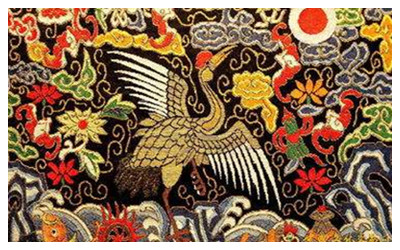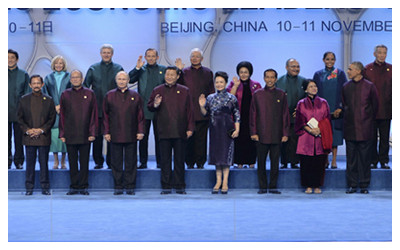
Song brocade was developed in Song Dynasty. As it mainly originated from Suzhou City, it is called "Suzhou Song Brocade". It is one of the four most famous brocades in China.
Brocade is a class of richly decorative shuttle-woven fabrics, often made in colored silks and with or without gold and silver threads. The name, related to the same root as the word "broccoli," comes from Italian broccato meaning "embossed cloth," originally past participle of the verb broccare "to stud, set with nails," from brocco, "small nail," from Latin broccus, "projecting, pointed."
History of Suzhou Song Brocade
Suzhou, the well-known ancient silk city in China, teems with brocades, embroideries, damasks and silk products. In Tang and Song dynasties, Suzhou was the national silk production center. In Ming and Qing dynasties, Suzhou was famous for Suzhou Weaving Office. The imperial weaving and folk silk manufacturing saw both production and marketing thrive at that time. It was so famous that "the sound of looms could be heard in almost half of the southeast of Suzhou".
Suzhou Song Brocade can be traced back to the Spring and Autumn Period. At that time, noblemen in Wu State located in regions south of the Yangtze River had used brocades widely in everyday life. The brocade weaving skills were improved completely in Northern Song Dynasty through development in previous historical periods. In Southern Song Dynasty, an official workshop was established in Suzhou. A brand new type of brocade with delicate texture and distinctive craftsmanship, namely Suzhou Song Brocade, took shape at this time. It was not only used in the making of gowns and dresses but also widely used in skillful mounting of scrolls of calligraphy or painting works. It had more than 40 types in total. In particular, the application in the mounting of calligraphy and painting works allows the gorgeous brocades to be preserved together with calligraphy and painting masterpieces. In Ming and Qing dynasties, Song Brocade was applied more widely, especially during the reign of Emperor Kangxi and Emperor Qianlong in Qing Dynasty (1662-1795), the development was in full bloom in history. The scroll of painting entitled "Pure Land", the masterpiece housed by the Palace Museum, is the typical Double Brocade produced in Suzhou during the reign of Emperor Qianlong in Qing Dynasty. It is rated as a rare treasure.
Features of Suzhou Song Brocade

Song Brocade, which is produced in Suzhou, has exquisite craftsmanship and elegant artistic style. It carries on the traditional style and characteristics of Song Dynasty. Different from other types of fabrics that were popular in Yuan and Ming dynasties, such as brilliant gold-wefted brocade, and brocaded satin, Song Brocade is a kind of brocade knitted with warp and weft concurrently. It not only inherits the skill of warp-patterned brocade in Qin and Han dynasties but also inherits the style of weft-patterned brocade in Tang Dynasty, integrating the two characteristics. Song Brocade can be divided into Double Brocade, Fine Brocade, Box Brocade and Small Brocade according to the structure of the fabric, level of craftsmanship, quality of material, thickness of fabric and application performance, etc.
At the APEC dinner in Beijing in November 2014, the leaders and their spouses who attended the meeting dressed in Chinese special clothing which are the Song Brocades produced in Suzhou.
There are so many procedures for manufacturing traditional Song Brocade. A finished product is made through over 20 procedures from silk reeling, dyeing to knitting. The product has the following basic characteristics: on the one hand, patterns are woven in a structure of warps interspersed with wefts; on the other hand, multicolored shuttles are cast in different combinations as to change the colors of the pattern to make the silk threads and structure more colorful on the surface of the fabric. The essence of the skill is subsequently absorbed by Cloud Brocade and finally handed down to be used today as well. As far as the artistic style is concerned, the varied geometry is regarded as the framework and knitted with natural flowers and decorative pattern of happiness and auspiciousness inside. Decorated with harmonious yet contrasted colors, it is bright-colored in good taste, simple, unsophisticated and graceful. For this reason, since Song Dynasty, Song Brocade had replaced warp-patterned brocade in Qin and Han dynasties and weft-patterned brocade in Sui and Tang dynasties and developed rapidly in Song, Yuan, Ming and Qing dynasties. With high historical and cultural value, Song Brocade is not only an important part of excellent traditional silk culture in Suzhou, the ancient silk city, but also the masterpiece representing traditional silk skills in China.
Due to economic transition and long-term neglect of the skills, the traditional Song Brocade craftsman workshop has been out of business and lots of craftsman, tools and pattern designs have been lost. Therefore, it is urgent to take pragmatic measures to resume and protect the skills.
In 2006, Song Jin was included in the first batch of national intangible cultural heritage lists. The inheritance unit is the Suzhou Silk Museum, and Qian
Xiaoping is the only national inheritor. In September 2009, the UNESCO Intergovernmental Committee for the Protection of the World ’s Intangible Cultural Heritage added Song
Jin to the World ’s Intangible Cultural Heritage.

 Song brocade was developed in Song Dynasty. As it mainly originated from Suzhou City, it is called "Suzhou Song Brocade". It is one of the four most famous brocades in China.
Song brocade was developed in Song Dynasty. As it mainly originated from Suzhou City, it is called "Suzhou Song Brocade". It is one of the four most famous brocades in China. Song Brocade, which is produced in Suzhou, has exquisite craftsmanship and elegant artistic style. It carries on the traditional style and characteristics of Song Dynasty. Different from other types of fabrics that were popular in Yuan and Ming dynasties, such as brilliant gold-wefted brocade, and brocaded satin, Song Brocade is a kind of brocade knitted with warp and weft concurrently. It not only inherits the skill of warp-patterned brocade in Qin and Han dynasties but also inherits the style of weft-patterned brocade in Tang Dynasty, integrating the two characteristics. Song Brocade can be divided into Double Brocade, Fine Brocade, Box Brocade and Small Brocade according to the structure of the fabric, level of craftsmanship, quality of material, thickness of fabric and application performance, etc.
Song Brocade, which is produced in Suzhou, has exquisite craftsmanship and elegant artistic style. It carries on the traditional style and characteristics of Song Dynasty. Different from other types of fabrics that were popular in Yuan and Ming dynasties, such as brilliant gold-wefted brocade, and brocaded satin, Song Brocade is a kind of brocade knitted with warp and weft concurrently. It not only inherits the skill of warp-patterned brocade in Qin and Han dynasties but also inherits the style of weft-patterned brocade in Tang Dynasty, integrating the two characteristics. Song Brocade can be divided into Double Brocade, Fine Brocade, Box Brocade and Small Brocade according to the structure of the fabric, level of craftsmanship, quality of material, thickness of fabric and application performance, etc. Ask Questions ?
Ask Questions ?